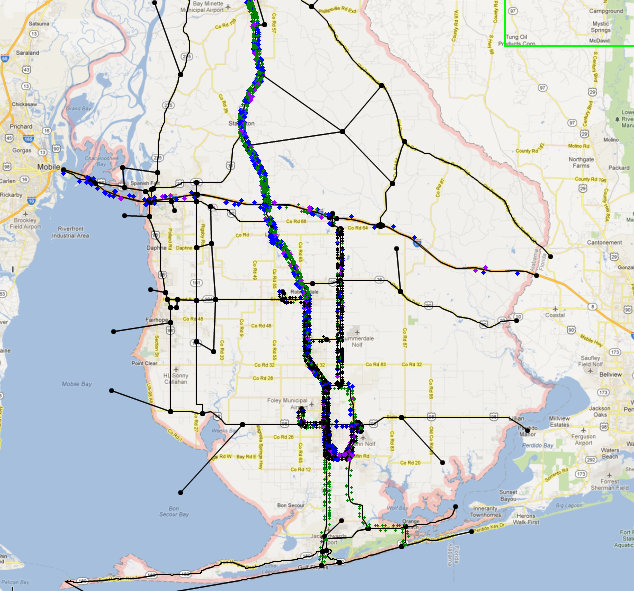As part of a $1.5 million grant from the U.S. Dept. of Commerce’s Economic Development Administration (EDA), The University of Alabama in Huntsville’s Center for Management & Economic Research (CMER) and Center for Modeling, Simulation, and Analysis (CMSA) , the Economic Development Partnership of Alabama (EDPA) and private partners will join to support ongoing economic recovery in Alabama’s 67 counties. The Disaster Relief Opportunity grant from FY 2012 funds was announced by EDA during the week of March 4-8, 2013. (posted HUNTSVILLE, Ala. -March 22, 2013)
The grant is designed to help communities build targeted strategies to diversify their economic base and develop plans to mitigate the impact of future disasters such as the 2010 BP oil spill or 2011 tornado outbreak.
“UAHuntsville is proud to continue our partnership with EDPA in enhancing Alabama’s economic development toolkit by expanding its modeling and simulation capabilities,” said Jeff Thompson, director of UAHuntsville’s Center for Management and Economic Research. “UAHuntsville, in concert with other research universities in the state, can help lead the development of Alabama’s 21st century economy with precisely these kinds of partnerships.”
Dr. Wes Colley, a senior research scientist at UAHuntsville’s Center for Modeling, Simulation and Analysis (CMSA), said the research will expand the capabilities of local and state leaders to see the growth or recovery opportunities for the state’s industries, perhaps before individual communities or companies can see them.“UAHuntsville wants to provide increased potential for Alabama to take advantage of economic opportunities first, before our competitors,” Dr. Colley said. “Working with EDA to find faster and better ways to recover from economic disasters, like the oil spill or tornado outbreak, is a particular way for us to help Alabama create a more robust economy for its citizens, companies and communities.”
The work of the grant will span a 15-month time period. At the grant’s completion, EDPA will present its findings to Gov. Robert Bentley and the Alabama Economic Development Alliance. The project is funded through the FY 2012 Disaster Relief Opportunity, administered through the EDA. Each disaster recovery investment is intended to support a community’s long-term recovery, spur job creation, leverage private investment and promote disaster resiliency.
The Disaster Relief Opportunity funding builds on work recently done with a 2010 EDA Oil Spill grant award. That work was conducted in eight southwest Alabama counties affected by the BP oil spill. Plans are to make the tools and information developed during the oil spill project available to the remaining 59 counties.
The funding will help to ensure Alabama’s economic resiliency by:
- Better cataloging and marketing the state’s economic development assets, including its communities.
- Providing visualization tools that can help state and local officials understand current conditions and plan for a brighter future.
- Better cataloging and analyzing information on several of Alabama’s key industries in order to boost resiliency and create opportunities for job creation.
- Add critical tools that support and assist communities in developing long-range strategic planning at the local level that aligns with Accelerate Alabama, the state’s strategic economic development plan developed by Gov. Robert Bentley’s task force.
A goal is to minimize dislocations resulting from a major disaster by promoting job creation, supporting economic diversification or fostering disaster resiliency. The project consists of three components: target sector analysis; simulation and visualization tool; and transportation and logistics analysis.
- Target Sector Analysis: EDPA staff and UAHuntsville staff will use methodology developed for the eight-county oil spill region to provide an in-depth analysis of four business sectors. They are automotive, aerospace and two agriculture sectors to be announced. The analysis will identify industries with the greatest potential to create jobs and interconnectivity in urban and regional areas.
- Visualization and Simulation: The visualization and simulation capability will provide virtual tours and flyovers of existing buildings and visualize future developments. This is a powerful tool for helping to identify new ways to rebuild a community, and communicate plans to do something different than rebuild the past.
- Transportation and Logistics Analysis: UAHuntsville will use sophisticated modeling tools to replicate the transportation model across the state and analyze the flow of goods for the four business sectors. A primary enabler of economic activity in a region is its transportation infrastructure and the resilience of the infrastructure in the face of disaster-induced disruptions. The resilience of freight mobility will be studied in the context of natural disaster-caused damage to the transportation system, compare improvement strategies for mitigating negative economic effects and investigate opportunities for new links in the supply chains to be established in the state.




